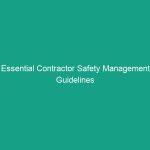Good Morning Team!
Today, we’re going to chat about something that affects each of us every day: safety in the workplace. Our focus is on essential Safety tips and why it’s crucial not to overlook the little things in Health, Safety, and Environment (HSE) practices. These minor details can make a significant impact on our overall Safety and well-being at work.
Understanding Essential Safety Tips
When we talk about essential safety tips, we’re referring to fundamental practices that help prevent accidents and injuries in the workplace. These tips may seem minor or obvious, but overlooking them can lead to severe consequences.
For instance, wearing Personal Protective Equipment (PPE) might feel like a hassle some days, but it’s a simple yet critical measure to protect ourselves from workplace Hazards. Remember, safety isn’t just about following rules; it’s about fostering a culture where everyone feels responsible for their safety and the safety of their colleagues.
Many employees believe they are invulnerable to accidents, thinking, “It won’t happen to me.” This misconception can be dangerous. Accidents often occur when we least expect them, which is why staying vigilant and adhering to safety protocols is vital.
Key Hazards, Risks, and Safety Considerations
In our work environment, numerous hazards can arise from seemingly minor oversights. Here are some key risks associated with neglecting essential safety tips:
- Slips, Trips, and Falls: These are among the most common workplace accidents. A small spill or an untidy workspace can lead to serious injuries.
- Improper Use of Equipment: Failing to follow Safety Guidelines when using tools or machinery can result in accidents that may have been easily preventable.
- Neglecting PPE: Not wearing appropriate protective gear might seem small, but it significantly increases the risk of injury.
- Lack of Communication: Not reporting hazards or safety concerns can lead to accidents that could have been avoided with proper communication.
Neglecting these aspects can lead to real-world consequences. For example, a slip leading to a sprained ankle can result in lost workdays, impacting productivity and team morale.
Best Practices, Procedures, & Actionable Advice
Now that we understand the risks, let’s discuss some Best Practices to mitigate these hazards:
1. Maintain Cleanliness and Organization
Keeping your workspace tidy can prevent many accidents. Regularly clean up spills, remove clutter, and ensure walkways are clear. A clean workspace fosters not just safety but also productivity.
2. Use Equipment Properly
Always follow the manufacturer’s instructions when using tools and machinery. If you’re unsure about how to operate a piece of equipment safely, ask a supervisor for guidance. Remember, there’s no shame in seeking help.
3. Always Wear PPE
Make it a habit to wear your Personal Protective Equipment, such as gloves, helmets, and goggles, at all times when required. Consider it an essential part of your work attire.
4. Communicate Openly
If you notice a safety hazard, report it immediately. Encourage your colleagues to do the same. Open dialogue about safety can help identify potential issues before they become problematic.
5. Participate in Safety Training
Take advantage of any training provided by our organization. These sessions are designed to equip you with the knowledge and skills to stay safe on the job.
Case Study: A Lesson Learned
Let me share a brief story. A colleague once ignored a small oil spill on the floor, thinking it wasn’t a big deal. Unfortunately, someone else slipped, resulting in a sprained wrist. This incident could have been avoided with a simple clean-up. Let’s learn from this and stay vigilant about the little things!
Regulations, Standards, and Compliance
Compliance with safety Regulations is not just a legal obligation; it is a commitment to our well-being. Familiarize yourself with OSHA (Occupational Safety and Health Administration) standards that apply to our job site. These guidelines are established to protect us and ensure our workplace is safe.
Remember, when we follow these regulations, we contribute to a safer environment for everyone. Not only does compliance protect us from potential fines and penalties, but it also enhances our organization’s reputation and morale.
Employee Engagement & Discussion
Now, I’d like to hear from you. What safety challenges have you encountered related to essential safety tips? Have you noticed any hazards that we should address? Let’s share our experiences and learn from one another.
Engaging in discussions about safety can help us identify areas for improvement and foster a culture of safety in our workplace. Remember, every voice matters!
Conclusion & Key Takeaways
In summary, essential safety tips are crucial in maintaining a safe work environment. By being aware of the little things—such as keeping your workspace clean, using equipment properly, wearing PPE, and communicating openly—we can prevent accidents and injuries.
Let’s take these practices to heart and make them a part of our daily routine. Remember, safety is a shared responsibility, and we all play a role in making our workplace secure.
Thank you for your attention today! Let’s commit to prioritizing safety and looking out for one another. Together, we can create a workplace where safety is at the forefront of everything we do.


